レポート

The world’s food system creates $10 trillion in value and feeds billions of people, but it also faces big challenges. Food and its production have unintended consequences, including pollution. The system overfeeds some and undernourishes others. These consequences generate hidden external costs, such as health issues, environmental damage, and economic losses.
Written in collaboration with
Written in collaboration with
![]()
That’s just a sampling of hidden costs that are unaccounted for in the broader consumer products market. And those costs add up. In the food industry, for example, the total $11.9 trillion of hidden costs exceeds the value of the industry itself (see Figure 1).
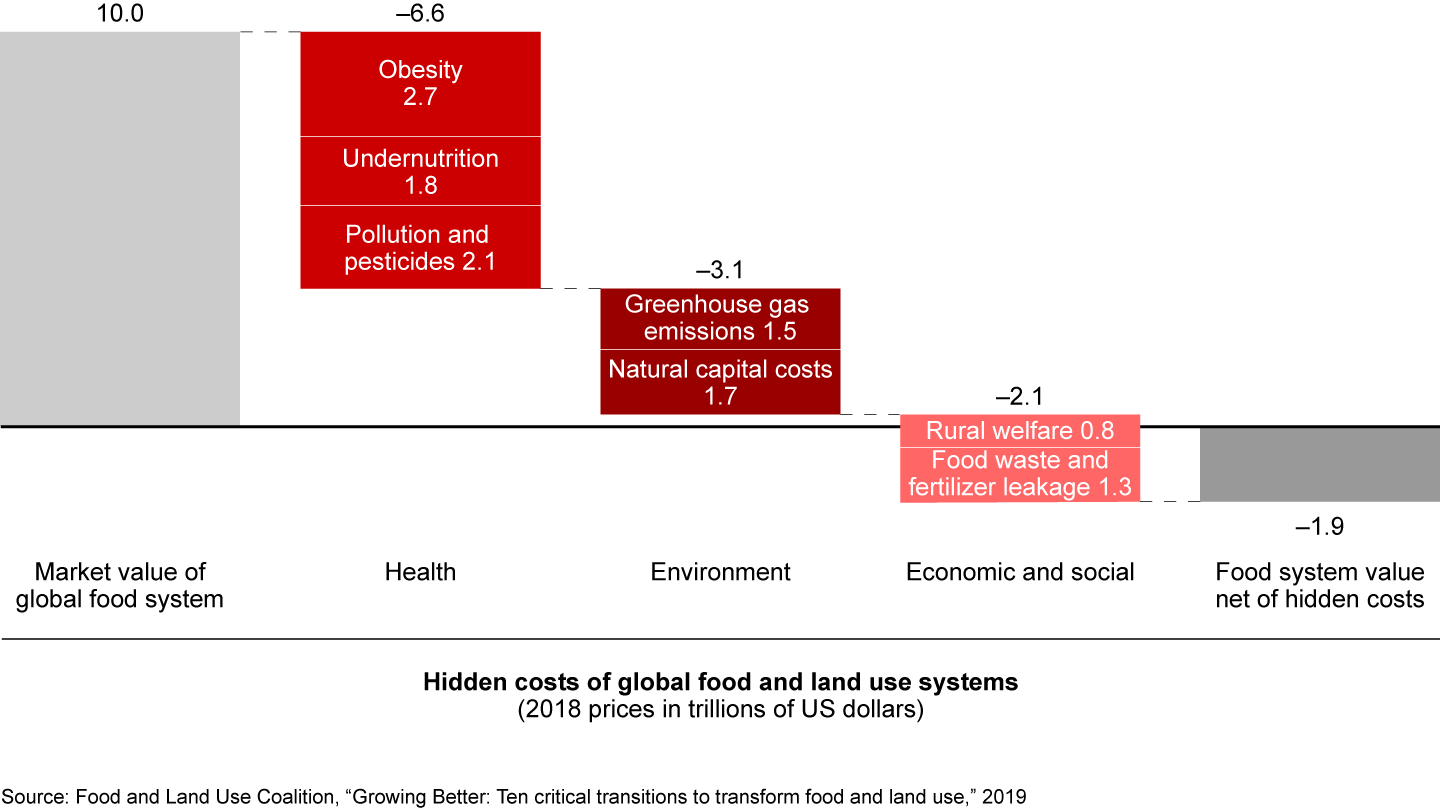

Yet this problem also creates an opportunity for consumer goods brands. As consumers, retailers, and investors alike grow more aware of these issues, that awareness is translating into increased demand for more sustainable goods.
Purpose-driven brands: Positive change, fewer hidden costs
A new generation of purpose-driven brands is taking up this challenge and opportunity. An increasing number of companies are making it the mission of their brand to solve a specific environmental, social, or governance (ESG) issue. These ESG-focused, or purpose-led, brands make that mission—whether solving an environmental issue such as pollution or a social issue such as forced labor—the focus of every part of their business, from supply chain to final product.
Purpose-led brands create a simple, compelling message to educate consumers about the issue at the heart of their mission, and they often use one clear data point to anchor the message (see Figure 2). For example, Dove brands advocate a positive relationship with beauty and cite data about how typical beauty imagery harms the self-esteem of women and girls. Beyond Meat cites data about the emissions and land use costs of beef and argues for “a better way to feed our future.” Each of these brands illustrates how clarity of purpose can change consumer behavior while creating category growth. And as these brands find footholds in the mainstream market, their success has a cumulative effect on their industry and the wider world. As their scale grows, so does their impact.
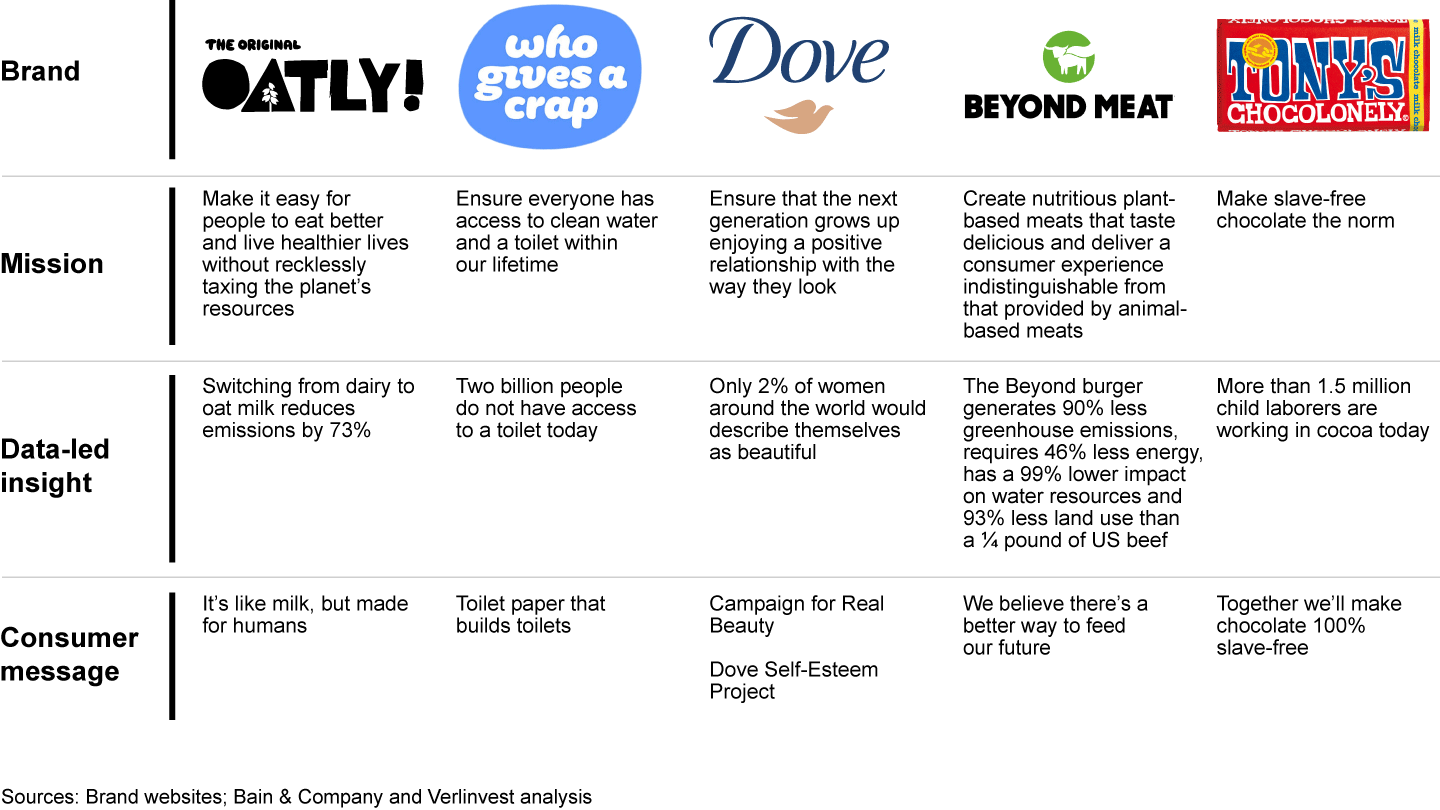

One surveyed founder noted, “Being specific on what you are trying to solve is really key.” For example, Tony’s Chocolonely focuses on eliminating child labor and improving farmer livelihood, which has a powerful effect on reducing hidden costs in the chocolate industry (see Figure 3).
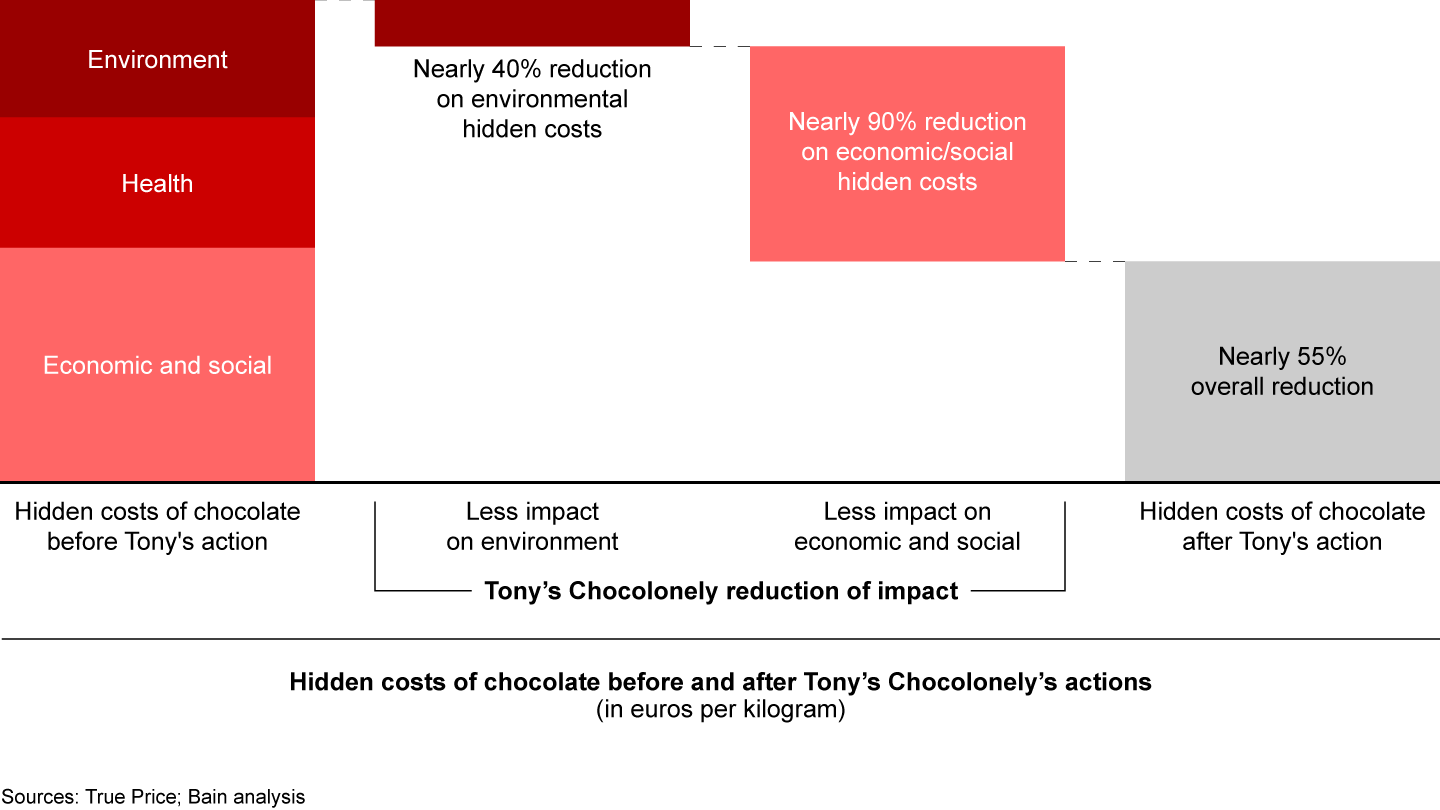

Beyond their sustainability goals, purpose-led brands also strive to deliver great taste/performance and attractive packaging at an accessible price point to ensure mass-market appeal. To provide true value, their products offer both positive changes in the world and high quality. According to Richard Reed, cofounder of climate-conscious drink brand Innocent, this is a hallmark of successful ESG-conscious goods. “Don’t ever expect consumers to buy your product because it is ethical at the expense of taste and performance,” says Reed.
“Creating a purpose-led product doesn’t mean making compromises with the [brand’s] taste and visual aspects.”
Bain’s research confirms Reed’s assertion. Our global survey of 60 brands across eight consumer goods categories found that the most successful companies address consumer demand for both quality and sustainability. Bain & Company’s Elements of Value® research, which aims to reveal what consumers perceive as valuable about a brand, identifies 30 fundamental Elements of Value that fall into four categories: functional, emotional, life-changing, and impact. In the global impact category, we recently added three sustainability-related Elements of Value: cares for the earth, ethical, and invests in well-being.
Purpose-led brands score highest on those sustainability-focused Elements of Value, while also offering three times as many Elements of Value, such as design, sensory appeal, or “premiumness,” than incumbent brands (see Figure 4).
Purpose unlocks a flywheel of consumer, employee, retailer, and investor demand
When purpose-led brands promote sustainability through their products, they create a virtuous cycle that forms the heart of a new, self-reinforcing model of purpose-driven capitalism. Rather than simply capitalizing on existing trends, purpose-led brands typically gain traction by creating issue awareness and shining a light on lesser-known problems. This piques consumer interest in their products, spurs retailer demand, and attracts and motivates high-quality employees. That, in turn, leads to higher growth and greater interest from investors (see Figure 5).
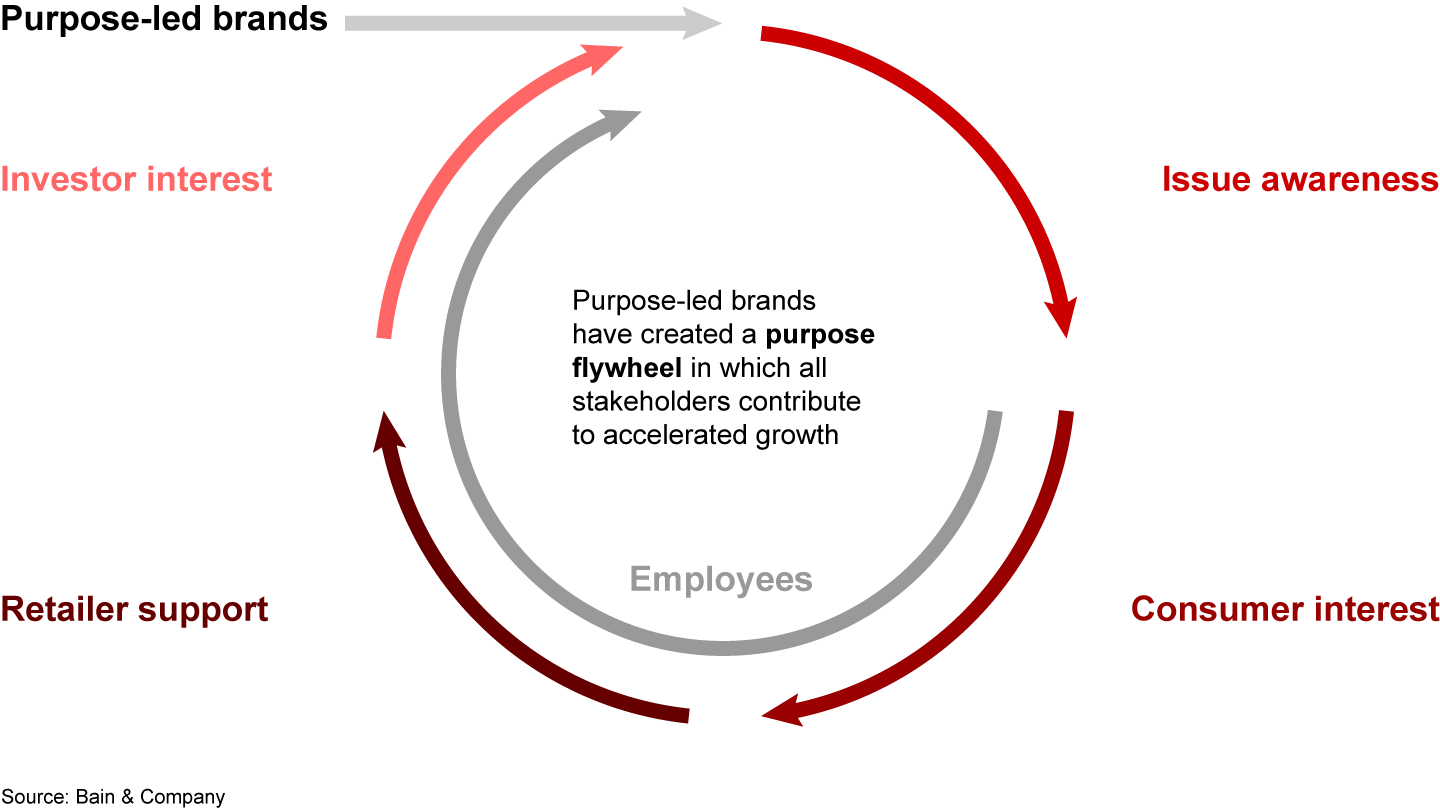

For the many employees looking for a job that does more than simply pay the bills, purpose-led brands offer an opportunity to also have a positive impact on the world. More than 40% of millennials say they seek jobs with a purpose. And purpose-led brands provide such employees with agile environments where test-and-learn practices and innovation are encouraged. While the innovation budgets of incumbent companies are frequently trimmed to as little as 1% to 2% of sales, purpose-led brands often spend far more on research and development (R&D). At Beyond Meat, for example, R&D accounts for 11% of sales.
“One of the main reasons employees want to come to work in our firm is because their values are aligned with ours and they want to help our firm have an impact in the world.”
“Embedding sustainability more in our organization accelerated creativity, leading to three times as many innovations”
The issue awareness raised by purpose-led brands also sparks consumer interest. A growing number of consumers say that ESG is among their buying criteria, with 14% reporting that it is their top criteria (see Figure 6). Another 27% of consumers rank the planet as their third most important priority after health and quality. A Bain consumer survey also showed that more than 70% of consumers are willing to pay a reasonable premium (approximately 10%–25%) for sustainability.


The youngest consumers are more willing to pay for sustainability, even at lower income levels. In fact, age is one of the most significant differences between the consumer demographics of incumbents and those of purpose-led brands, whose customers tend to be younger and more focused on ESG and lifestyle. Millennial and gen Z consumers are especially sensitive to sustainability issues and tend to seek out purpose-led brands more than any other generation.
“Newer generations learn at school what sustainable food is. They’re starting to influence the purchasing of their parents, and they will soon have their own purchasing power, which will accelerate the trend.”
This demand, especially among valuable young consumers, makes ESG-conscious goods particularly attractive to retailers. Within the next five years, millennials, who already over-index on purchasing sustainable goods, are set to have the highest purchasing power of any consumer group. Millennials constitute 50% of the market for purpose-led brands, yet represent only a little more than 30% of the market for incumbent brands (see Figure 7).
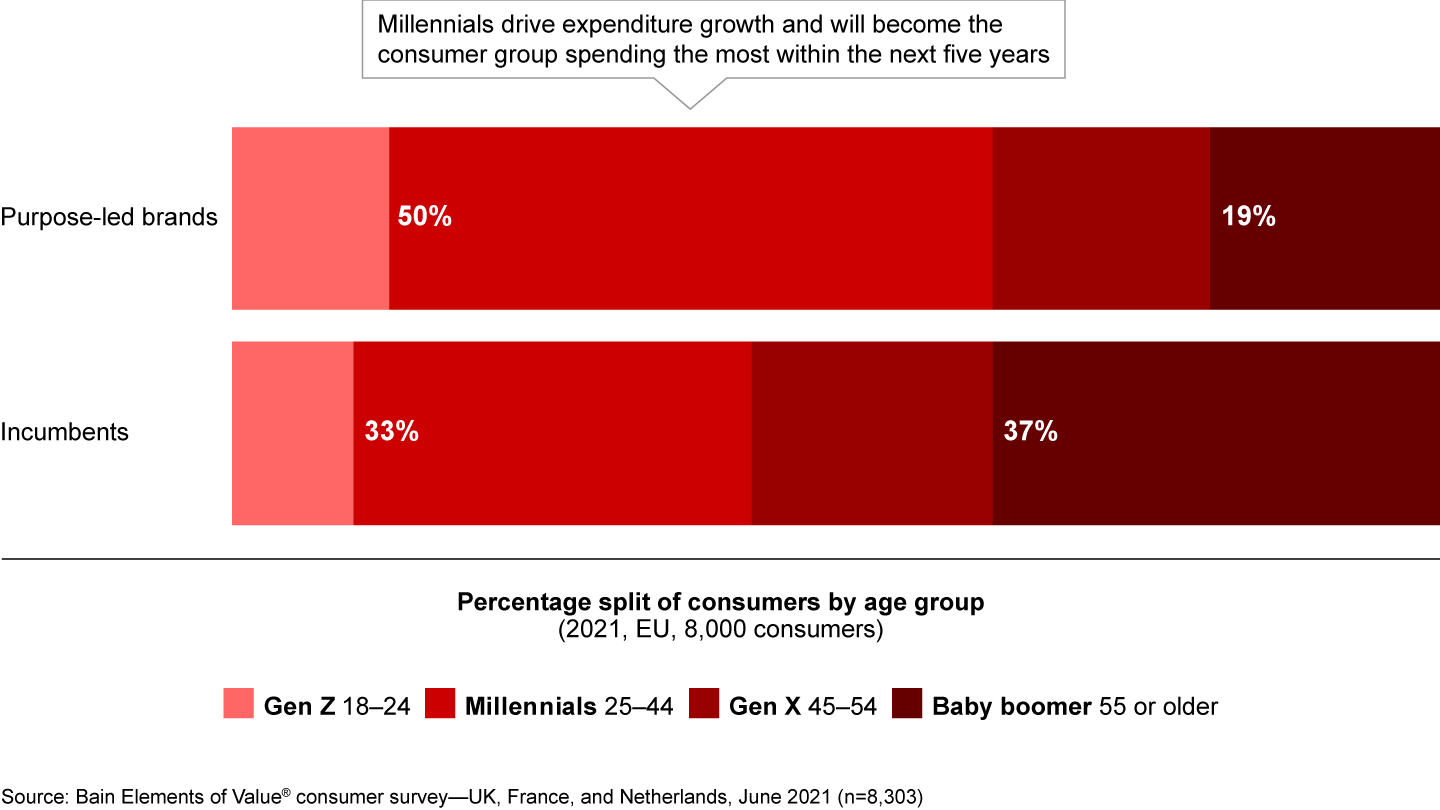

The effects of these spending trends are clear: Purpose-led brands bring value to retailers’ store shelves and bottom lines, and retailers are seeking products that attract this millennial spending.
“Sustainable insurgents bring profit and traffic,” says Milena Lazaraveska, formerly of Sainsbury’s Future Brands team and currently leader at Delivery Hero. “They increase the basket size and value. They bring incremental sales to the category, new customers, differentiation, and premiumness.”
In other words, insurgent brands add value to their category, bringing innovation, emotional engagement, and money back into categories where price and promotion had become the dominant levers of engagement.
Customers, employees, and retailers aren’t the only ones taking notice. Observant investors also have tracked the rapid growth rates of purpose-led brands, with investors large and small pouring money into the category. As it becomes clearer that sustainability can be a major source of growth, many investors see purpose-led brands as a key to future-proofing their portfolios.
“Sustainable investment assets grew to $35.3 trillion globally last year amid mounting concerns about societal inequities and climate change,” the Global Sustainable Investment Alliance noted last year, according to a Bloomberg article. “That’s about $1 of every $3 managed globally seeking out a profit from environmental, social, and governance concerns.”
In short, fired by the flywheel, purpose-led brands promise value across the spectrum, from consumers and employees to retailers and investors. Yet to fully realize that promise, purpose-led brands, whether created by new insurgents or by incumbents who recognize the value of this growing market, still face one major hurdle: achieving scale.
From niche to mainstream: How successful purpose-led brands scale
The success of purpose-led brands has led to a large number of new, ESG-focused entrants. Between 2019 and 2020, the number of new companies espousing an ESG mission more than doubled. Today, 35% of all new consumer products start-ups have a clear ESG mission, a tenfold increase since 2005 (see Figure 8).
This influx of brands has changed the very nature of the consumer products category: In 2020, “sustainability” outpaced “functional benefits,” “wellness,” and “convenience” among consumers’ top priorities when making buying decisions.
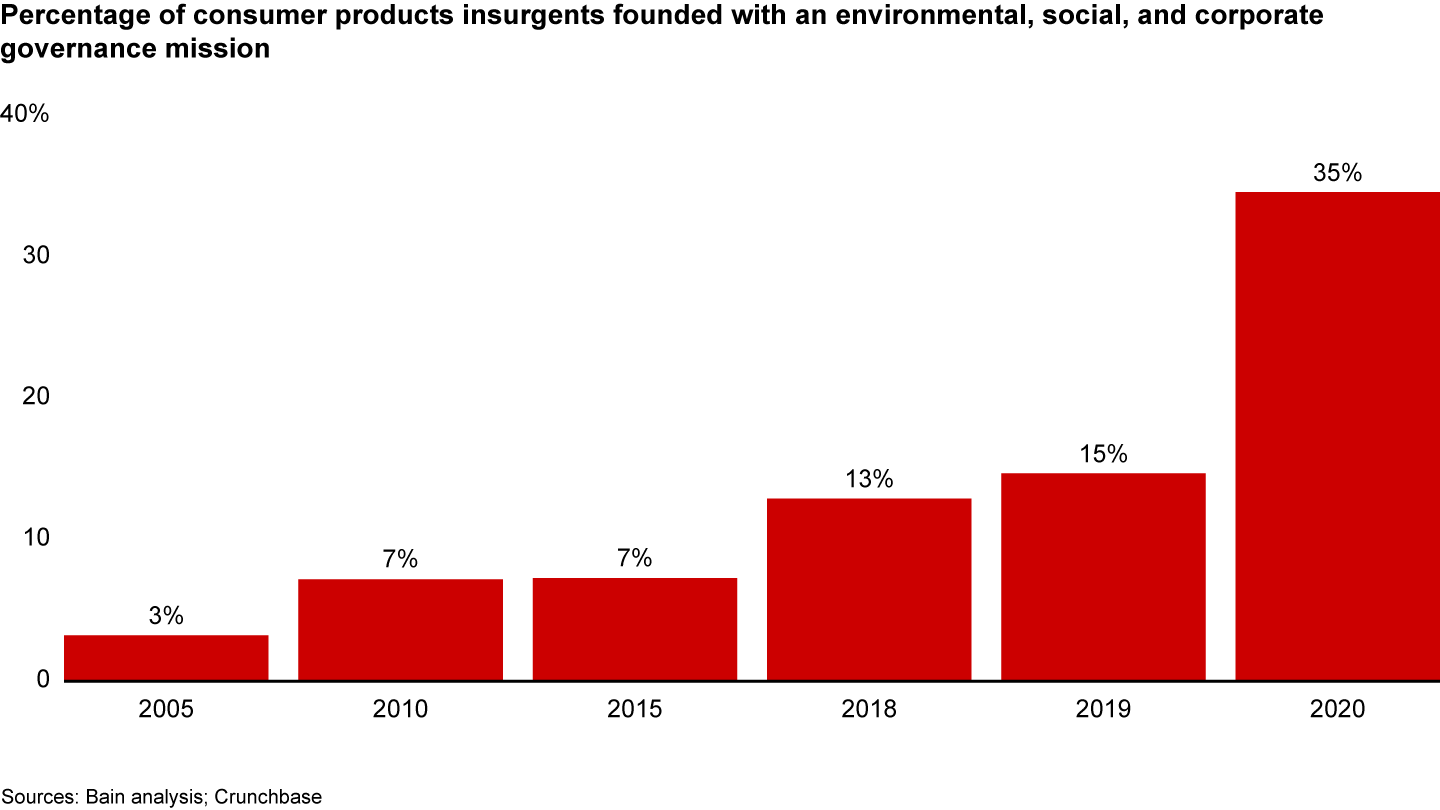

Yet not all of these brands survive. Even fewer make it to mass-market scale.
Companies often struggle to translate success as a start-up into mass-market acceptance. Bain research finds that of all consumer products start-ups, only 10% manage to achieve at least €10 million in sales. Even fewer, just 4%, make it to €50 million in sales.
But purpose-led consumer products start-ups face an even more arduous challenge. They must stay true to their ESG mission while scaling and once at scale. As they adapt to a more rapid pace, create larger supply chains, and hire more employees, they must find ways to preserve the ESG values that made them successful in the first place.
This is exactly what waste-conscious cleaning product manufacturer Blueland needed to do. Scaling its product line meant finding innovative ways to change long-held industry practices. Ultimately, these growing pains allowed Blueland to deliver its zero-plastic-waste cleaning products at scale while also creating a new supply chain. Doing so was difficult but important work that required staying aware of and avoiding unintended consequences.
For years, the dual difficulties of scaling and staying true to ESG principles made mainstream success a rare achievement. Purpose-led brands started between 2005 and 2010 faced a 14% success rate in reaching €10 million in sales. Comparatively, the index of all consumer products start-ups had a slightly better success rate: 18% reached €10 million in sales.
Yet market changes in the past decade, caused in part by the purpose flywheel, have eased the challenges these start-ups face. Today, 17% of purpose-led start-ups successfully grow to mainstream success. Remarkably, they now outperform the index of all consumer products, whose success rate has dropped to just 10% (see Figure 9).


Despite improving odds, success is still challenging. A recent Bain and Verlinvest global survey of purpose-led brands found 71% of founders mentioned barriers related to consumers and distribution as one of the leading challenges to scale, while 62% mentioned supply chain and 24% mentioned organization (see Figures 10 and 11).
“Ninety percent of new products don’t survive. It’s really hard to establish a brand.”
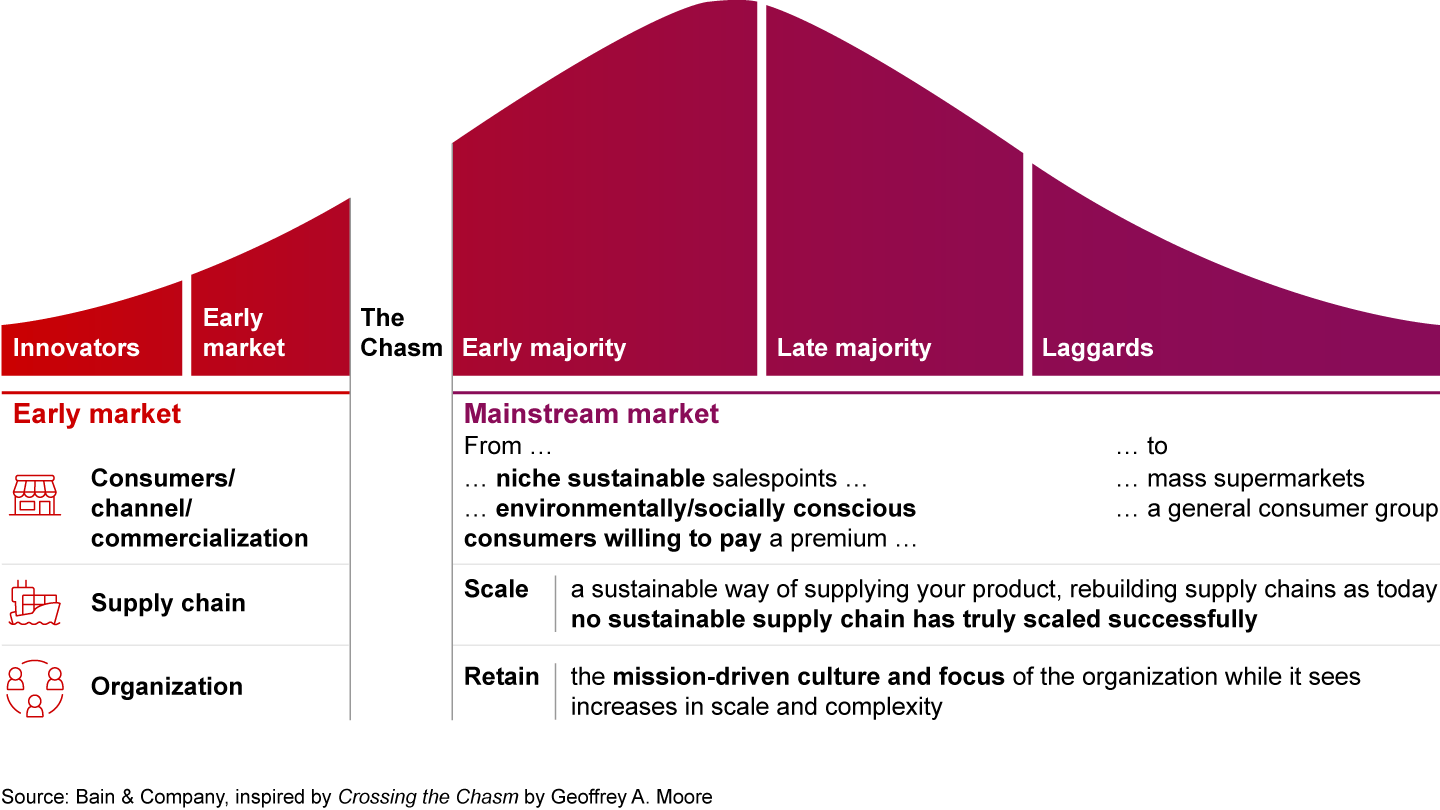

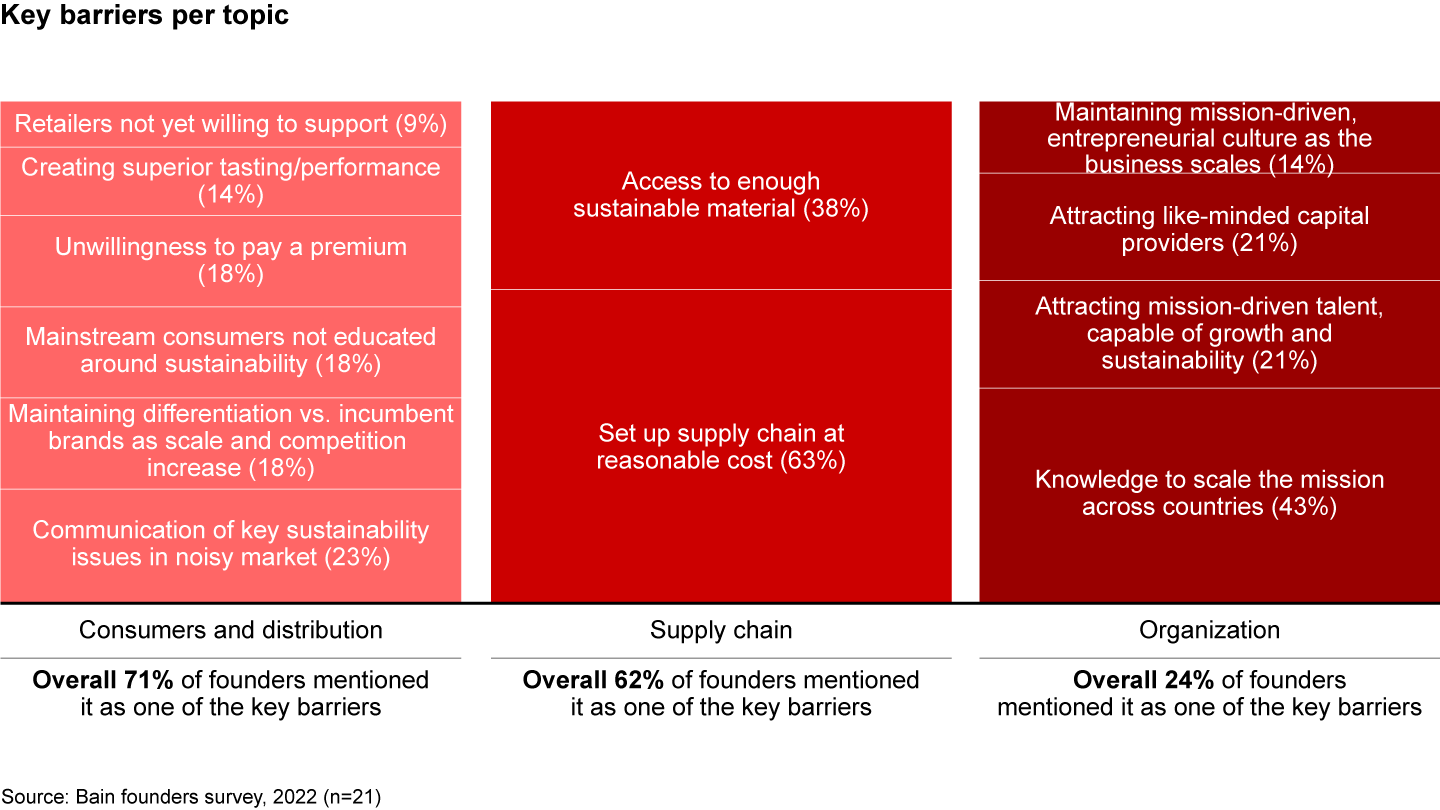

What differentiates the purpose-led brands that enjoy mainstream success from those that fail to break free of their niche? Successful purpose-led brands share three characteristics:
- A mainstream value proposition accessible at mass-market price points. The brand’s products resonate with mainstream consumer values, not just those of ESG-conscious consumers, and are distributed in mass channels, not just through niche, sustainable-focused retailers.
- A sustainable supply chain. The brand’s commitment to sustainability extends from concept to consumer. Often, as these brands disrupt the industry, they need to re-create/reinvent the supply chain to reach scale.
- An uncompromising sense of purpose. The brand’s people and organization live and work the brand’s mission, even with increasing complexity and less direct involvement by the original founders.
Working in concert, these three traits allow purpose-led brands to achieve mainstream scale.
A mainstream value proposition accessible at mass-market price points. In Crossing the Chasm, author Geoffrey A. Moore examined what it takes for technology products to move beyond the relatively small group of early adopters and “cross the chasm” to a larger, mainstream market. The growth of purpose-led brands requires a similar leap. A mainstream value proposition starts with effective consumer approaches, commercialization, and channels. Factors like price, performance or taste, and packaging are make-or-break for mainstream brands.
Purpose-led start-ups gain a foothold with a committed and loyal core following. These early fans buy the brand’s products specifically because of its commitment to an ESG value. An impressive 87% of these purpose-conscious consumers will pay more for sustainable goods.
Our research shows that a young purpose-led brand still has 70% to 80% of its consumers within the environmentally/socially conscious consumer group, and the other 20% are split between mainly health-conscious and lifestyle consumers. Once a brand achieves sufficient scale to cross the chasm between early and mainstream market, this consumer split shifts, with only about 20% of the consumers representing the environmentally and socially conscious group, though this is still about twice as many as for incumbents (see Figure 12).
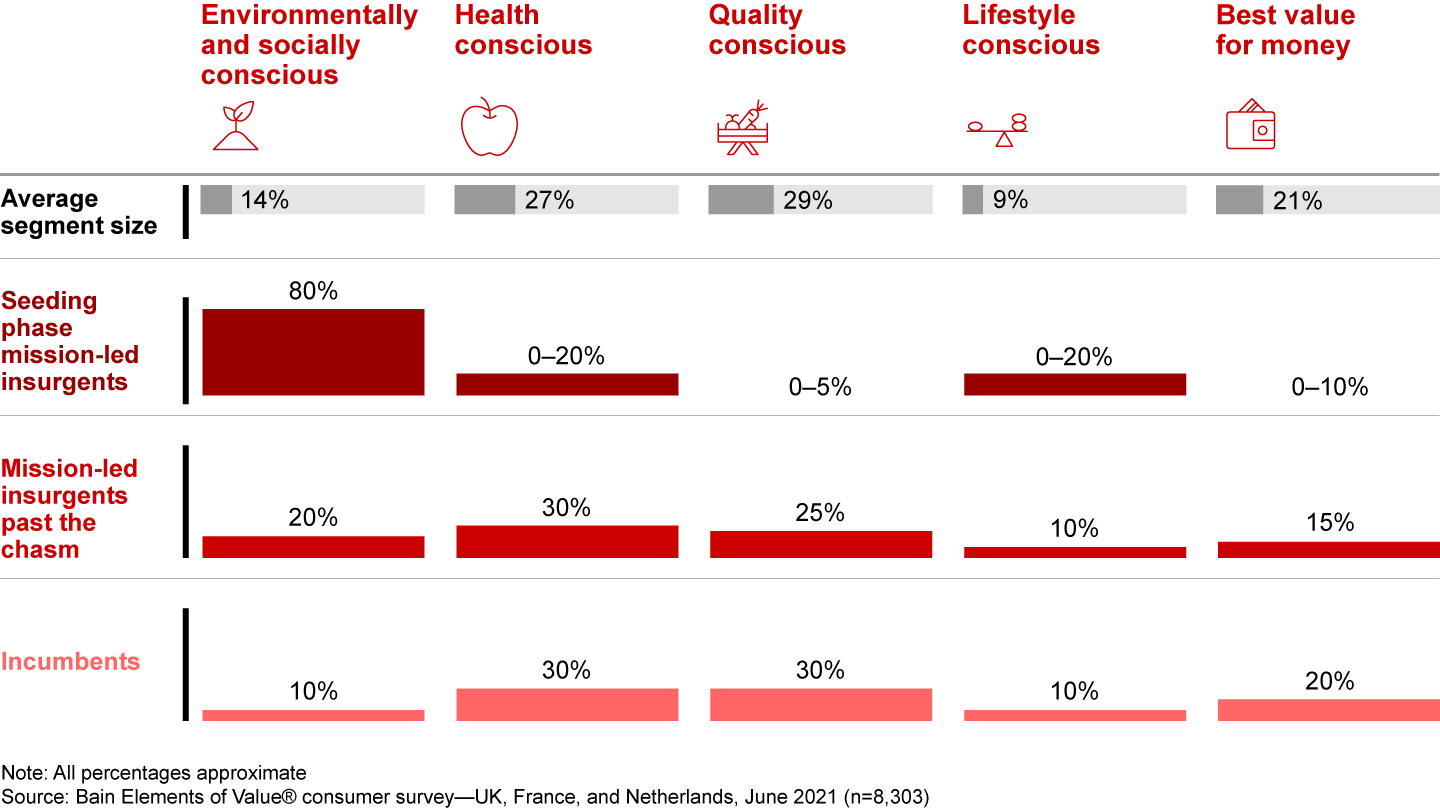

Growing beyond those environmentally and socially conscious consumers requires brands to address the key purchasing criteria of other groups, which are more linked to health, price, and quality. While a brand’s issue-conscious consumers may compromise slightly on performance, taste, or price to buy a sustainable product, the majority of mainstream consumers will not.
As start-ups, purpose-led brands are able to charge more for their products—sometimes as much as twice the price of comparable-but-unsustainable goods. But mainstream consumers will not pay more than 10%–25% more than the next highest priced comparable product. Tony’s Chocolonely, for example, is successful with a price that is about 25% more expensive than mainstream chocolate.
“Around 10% of the people are buying our chocolate because of our mission, the rest buys it for the product (good chocolate),” notes Henk Jan Beltman, Chief Chocolate Officer at Tony’s Chocolonely. “Brands need to appeal to the whole population, not just the 10%–15% who are passionate about the brand’s mission. However, you need to keep them onboard. If you lose your 10%, you become a company without a soul.”
As they scale, purpose-led brands also face the challenge of moving to new sales channels. As start-ups, some purpose-led brands, such as snack maker KIND, find success within small, sustainable retailers. Others, like Who Gives a Crap, find early success with a direct-to-consumer model.
Changing sales channels in stages can help start-up brands learn the ropes. KIND, for example, began in specialty retailers, then moved to convenience stores before graduating to large retailers. Vita Coco, the coconut water brand that aims to improve the coconut farming industry, took a similar approach, first releasing its product in yoga studios and convenience stores before expanding to retail “natural” channels (such as Whole Foods), and then finally entering mainstream retail outlets.
Another key factor in mainstream success is consumer outreach. Vocal, opinionated, and transparent engagement has proven to support insurgent brand success, with honest and open communication across channels building brand trust and credibility. From their earliest days, successful purpose-led start-ups are relentless communicators. Authentic, honest, accessible engagement makes fans more loyal and invested in the mission.
Communication has other benefits, too. It creates consumer inflection points, which are opportunities to drive behavioral change through education. For instance, Blueland uses its platform to tell its audience about the number of single-use plastic bottles in the environment. The messaging fosters engagement, helps the environment, and increases sales.
“You need to invest early in getting the positioning and visual identity of your brand right. Simplify your consumer message to capture and translate the spirit of founders into something easily digestible for consumers.”
Most purpose-led brands employ a bold, humanizing tone that consumers respond well to. The advocacy-over-advertising message they use also generates genuine engagement and an outsized share of earned media. After using these tools to convince mainstream consumers to buy, educating them about the brand’s purpose deepens their loyalty.
Innocent, for example, gains consumer interest with its distinctive tone of voice. Its packaging emphasizes that it uses recycled plastic and aims to be carbon neutral, making consumers feel good about using the product and enhancing customer loyalty.
A sustainable supply chain. In its earliest days, a purpose-led company chooses the issue at the center of its brand, and the brand’s supply chain also starts from this place of purpose. For example, Tony’s Chocolonely’s goal is to make all chocolate 100% slave-free, aiming to help the more than 1.5 million child laborers who currently work in cocoa. Similarly, Vita Coco’s goal is to enhance the lives of coconut farming communities.
When their products are still niche, purpose-led brands can carefully construct supply chains that avoid unintended consequences at every turn. Because they are still small, the capacity of their custom supply chains can keep up with product demand. But as these brands scale, they often run into two problems: setting up a sustainable supply chain at a reasonable cost (an issue mentioned by 48% of founders) and gaining access to enough sustainable material (mentioned by 29% of founders).
For example, as Vita Coco moved toward mainstream retail, product demand outgrew its supply chain. For years, Vita Coco carefully curated a supply chain that consisted of ethical farms in Brazil. But the supply chain’s capacity was limited. Increasing demand drove it to look elsewhere for sustainable coconut water.
Unfortunately, some of its new suppliers did not meet Vita Coco’s ethical standards. This created a dilemma, and the company had a decision to make. Should it source coconuts from farms with less-than-desirable practices to increase production capacity?
Vita Coco chose to stay true to its purpose. But that decision came at a cost. In some instances, it needed to further delay capacity increases because it couldn’t find factories with the right values. In other cases, it decided to work with those factories and farms to help them improve conditions through its Vita Coco Project. While searching for new suppliers, Vita Coco also found factories in Asia where coconut water was thrown away as a by-product of coconut flesh (used for coconut cream, for example). This directly led to a reduction of food waste and helped farmers and factories make more money out of coconuts.
Two new supply chain approaches can help companies scale production while staying true to their ESG mission:
- Work with existing major suppliers. Brands can scale their own supply chain by setting up a segregated supply chain within existing major suppliers. The Tony’s Open Chain was created in partnership with chocolate giant Barry Callebaut to provide mass-market capacity while meeting Tony’s Chocolonely’s ESG goals for cocoa. The hybrid chain enabled Tony’s Chocolonely—and other companies following in its wake—to source ethical cocoa. By working with an existing large supplier like Barry Callebaut, these companies gained direct access to scale, capital investments, and cost advantages.
- Create new, disruptive business models. Companies that create a novel, disruptive product have to work with suppliers to create sustainable production capacity from scratch. This was the case for Blueland, whose cleaning tablets were unique. Since no similar product existed, it had to create a new supply chain. Through a trial-and-error process, it taught suppliers how to create the new product at a reasonable price. Notably, working with existing cleaning product manufacturers was key to providing a built-in capacity to scale.
As they grow, these brands also need to monitor whether the act of scaling impacts their sustainability. This turned out to be the case, for example, in almond milk production, which becomes increasingly water intensive at scale.
When sustainability challenges arise, radical transparency mitigates negative sentiment and can help companies explain the trade-offs often required in decision making by purpose-led brands. This transparency is essential for both small and large purpose-led brands. It reinforces trust and loyalty among ESG-conscious consumers and helps to retain mass-market converts.
Oatly is a model for this transparency. Not only did it challenge the status quo by including carbon emissions labeling on its products, it also spoke openly about its shortcomings. At the end of 2020, for example, it issued a post on social media, written in capital letters: “Read about why our CO2 numbers are bigger than ever.” While the Oatly product still created fewer greenhouse gases than dairy milk, the company had not performed as well on emissions as it did the prior year as a result of temporary supply chain issues. In posting this message, the company acknowledged its shortcoming to garner and protect consumer trust while also demonstrating that it was addressing the issue.
As purpose-led brands grow, more stakeholders become literally and figuratively invested in them. Publishing performance against mission goals, as Oatly did, protects the brand’s relationship with its stakeholders.
As companies grow, stakeholders expect them to act on a wide range of sustainability issues. Not all of these issues will reflect the company’s flagship sustainability purpose, which we call a “spike,” but addressing secondary ESG goals can act as “shields,” reinforcing the company’s “good-for-all” messaging.
“Insurgents get more exposure as they grow, and they need to be prepared to answer any question on their sustainability across topics and … proactively communicate transparently on the topic so journalists can’t ask questions”
An uncompromising sense of purpose. This drives them to innovate, disrupt markets, and win loyal fans.
As brands grow, however, more employees work for the company and control becomes distributed, making unilateral action more difficult. Purpose-led brands cannot let these challenges compromise the brand’s mission. They also need to embed their ESG purpose in the front line and across the organization. Doing so helps employees clearly see the relationship between the company’s ESG goal and its long-term success.
“You need to put as much work into your values as in your mission. Values are what will ensure your purpose is lived on a day-to-day basis.”
Purpose-led start-ups that scale successfully owe their success in part to their organization. Brands can empower their organization to stay committed and aligned with the brand’s purpose by:
- hiring employees who believe in the brand’s mission, which makes onboarding faster and motivates them to stay with the company longer; and
- avoiding layers of bureaucracy so that critical players can focus on preserving the trust the brand has established with its core audience
“When we filtered future employees on purpose, we saw hiring went more easily and onboarding and integration were faster.”
KIND is an example of a brand that empowers employees to commit to the mission. KIND gives employees a stake in the company, asks each team member to think and act like owners, and encourages them to share ideas.
Purpose-led brands also owe their success to their founders. Through pride of ownership and ruthless commitment to purpose, founders model the energy that they rely on in their employees. Blueland CEO Sarah Paiji Yoo, for example, keeps a careful eye on the company’s social media notifications. As conversations about the brand happen, she stays in tune and addresses any problems as they emerge. She also leads by example, sending a clear message that sustainability is an area of zero compromise and motivating her team and suppliers to share that mentality.
One final organizational success factor underpins purpose-led brands as they transition from niche to mass market: an unyielding focus on what really matters to the consumer.
Capturing and using consumer feedback is critical to creating such a focus. While many companies create feedback loops, too often the feedback fails to make it to the right places in the organization or simply goes nowhere. The result: missed opportunities to refine messaging, improve a product, or foster loyalty.
Learning systems prevent this problem, transferring important lessons from consumers throughout the company and ensuring that feedback makes it to the employees who can use it to create positive change.
An effective learning system helped KIND respond to emerging customer demand. When a new entrant in the healthy snacking market created a snack bar with less sugar than KIND bars, KIND recognized that this signaled consumer demand for products with less sugar. Instead of lowering the sugar content in the KIND bar by adding emulsions, it created new products: the KIND nuts and spices line. By creating bars that didn’t contain fruit, the company lowered the amount of natural sugars in the new product line. This innovative approach allowed the company to respond to consumer demand while still staying consistent with the company’s nature-grounded brand.
What incumbents can learn from successful purpose-led brands
Insurgent start-ups are not the only ones who can learn from these lessons in how to scale. Incumbents looking to enter this growing market can apply many of the same lessons to their own companies, although the application may look slightly different. Our research suggests four ways that incumbents can adapt the scaling lessons of insurgents: reviving their Founder’s Mentality, creating sustainable supply chains, defining their own core purpose-led mission (or “spike”), and considering mergers and acquisitions (M&A) as a path to purpose-led brands.
Revive their Founder’s Mentality. In their infancy, many purpose-led insurgent brands inherently have what Bain calls the Founder’s Mentality. These companies eschew complexity and embrace higher degrees of risk and iteration. They focus on product quality and relentless customer service. They are fast, agile, and adaptable. Their employees are passionate about the company and its purpose.
In most cases, the companies’ founders make these decisions intuitively. They are ready to act and eager to disrupt the status quo. And they do so by focusing only on the few things that matter most.
Bain research finds that one of the differentiators for those small purpose-led brands that successfully grow to mainstream scale is that they preserve the Founder’s Mentality as they grow. Their sense of purpose is ingrained in everything they do. Companies that fail to do this and instead assign responsibility for purpose-driven goals to a specific person or department—for example, a sustainability directorate or ESG office—often see their sustainability goals turn into a siloed afterthought.
Employees in such companies are not motivated, energized, or rewarded by sustainability goals. Incumbents seeking to make a lasting transition to sustainability need to follow the example of successful insurgents, embedding a purpose-driven mindset into every function, from supply to sales. The following steps can help incumbents retrofit their own organizations to match the models of insurgents:
- Install leadership role models. “If the leader shows that this is the most important thing to further grow and be successful, teams will quickly follow,” says one executive at Reckitt Benckiser, a producer of health, hygiene, and nutrition products.
- Incentivize leaders (both senior and middle managers) to prioritize sustainability.
- Connect accountability for ESG with frontline goals. Sales, marketing, and business unit leaders should be accountable, and rewarded, for meeting sustainability goals.
- Train employees on the company’s purpose and ESG topics.
- Work cross-functionally on ESG issues and the company’s related goals, as the company would with innovation or other cross-functional topics.
Create sustainable supply chains. While small brands face challenges in scaling sustainably, incumbents face a “purpose bottleneck” as they figure out how to “green” an existing scaled supply chain. They also face a threat from the growing success and greener supply chains of insurgent brands.
Currently, 56% of consumer products companies’ emissions come from their supply chains (see Figure 13), so making a credible change in their sustainability position demands that incumbents find ways to rework their supply chains.
Of course, this is not a single mountain to climb. Converting an existing supply chain to be sustainable involves many changes, large and small. Yet incumbent brands that dare to make disruptive changes can prove their commitment to ESG principles.
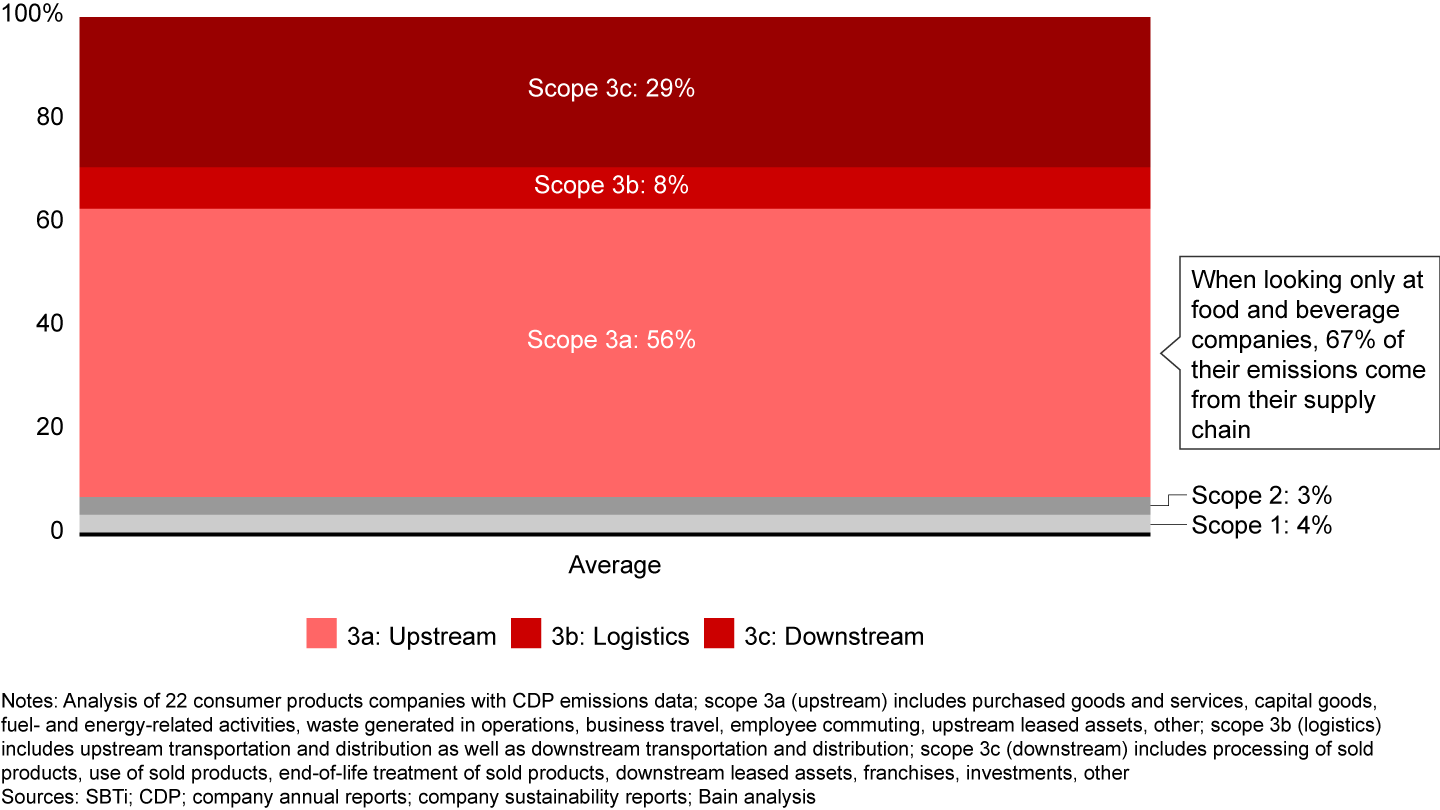

Define their core purpose-led mission (or “spike”) and embed sustainability as a core message. As incumbent brands tackle the transition to sustainability, a shift in focus toward sustainability spikes can help. Spikes are the topics that brands want consumers to care about—the topics for which they want their brand to be known and loved.
Too often, however, incumbent brands tend to focus on shields, the topics that are more important to core stakeholders. Shields are often less ambitious than spikes and tend to cover many different topics. But to really have an impact with consumers, companies need to focus on a simple message, typically with a maximum of two topics.
Transparent and authentic communication can help incumbents avoid criticism of greenwashing and change consumer perception of their brands. Frequency of communication also matters: Our research suggests 20% of an incumbent’s messaging and at least 100 social media posts per year should be related to sustainability, yet many incumbent brands do not reach those levels (see Figure 14).
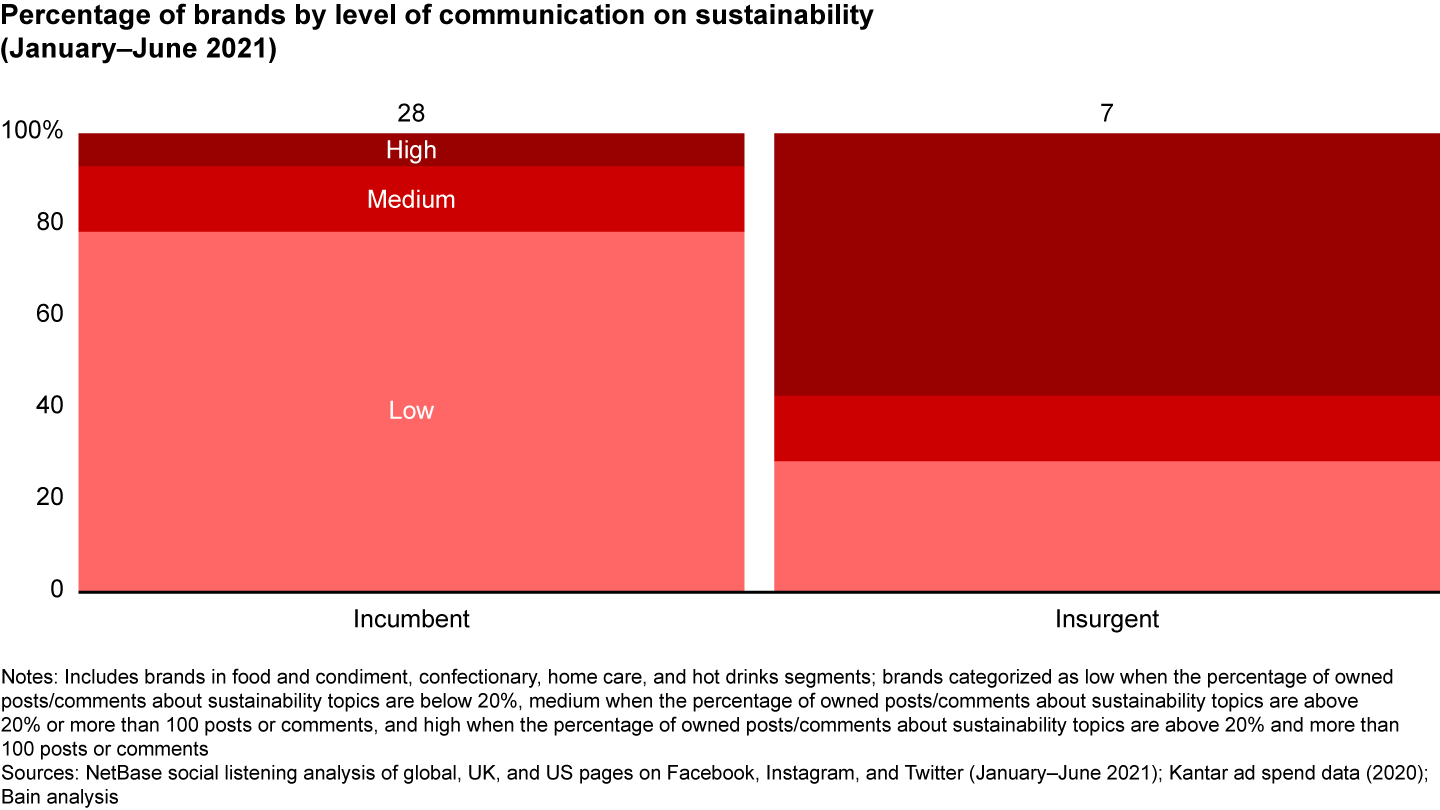

Use M&A as a path to purpose-led brands and to boost early ESG gains. Sustainable M&A represents a relevant and growing share of deals for incumbent companies. About 45% of M&A in the past 10 years, and 60% in the past five years, have involved a sustainable angle. This growth reflects investor interest in the sustainable consumer products market and offers incumbents a way to jump-start their entry into purpose-led products.
A new model for consumer products
As the consumer products industry seeks ways to address the hidden health, environmental, and socioeconomic costs of its business model, a new generation of purpose-led brands offers a path forward, one that is increasingly marked by successful scaling efforts.
These successful purpose-led brands offer excellent consumer value marked by radical transparency and clarity on trade-offs. They engage authentically with their consumer base about the issues those consumers care about. By doing so, they are adding value into their categories, offering a host of innovation and premium products at mass-market price points.
At the same time, they are changing supply chain models, with a willingness to collaborate where they can while also challenging old, unsustainable models. And they offer agile work environments marked by test-and-learn approaches and motivated teams of employees eager to give their all to make a difference in the world.
Despite the economic headwinds and supply chain disruptions the consumer products industry faces today, companies of all sizes have an opportunity to see a significant valuation reward while tackling some of the world’s most significant problems.

About Verlinvest
Verlinvest is an international, family-backed evergreen investment company. It partners with visionary entrepreneurs who are driving consumer revolutions and building the next generation of category-defining brands that will positively impact the consumer sector for many years to come. Established in 1995, with offices in New York, Brussels, London, Mumbai, and Singapore, Verlinvest focuses on growth-stage companies in FMCG, healthcare, and digital retail.